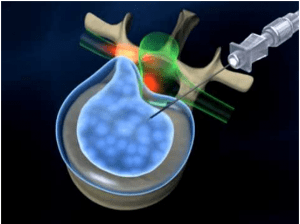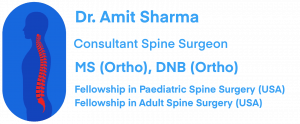LASER Spine Surgery
LASER Spine Surgery in Mumbai
LASER spine surgery is a loosely used term by patients to indicate minimally invasive spine surgeries. In fact, LASER (Light Amplification by Stimulated Emission of Radiation) is a type of light. It can be used for certain specific spinal procedures. LASER light is delivered at target pathology with the help of probes for a specific amount of time. LASER spine surgery is primarily done under local anaesthesia as a day care procedure.
LASER Spine Surgery: How it works
- LASER can be used as a stand-alone treatment, as in lumbar disc pathologies. LASER light is emitted inside the disc space near the site of disc prolapse. This generates local heat and coagulates/ liquifies disc tissue causing reduction in disc pressure. Pressure on spinal nerve is reduced leading to symptomatic improvement.
- Generated heat will also destroy nerve endings in the disc space, leading to decreased pain of disc degeneration.
- Disc tissue released in spinal canal can be a source of inflammatory reaction around the nerve roots. This will irritate spinal nerve in addition to mechanical pressure caused by disc tissue. LASER will neutralize this disc tissue, leading to reduction in inflammation around the spinal nerve roots.
- LASER is also commonly used with endoscopic spinal surgeries to remove part of bone, ligament or disc compressing spinal nerves.
Disadvantages/ Limitations of LASER Spine Surgery:
- LASER can damage spinal tissue if delivered at wrong site.
- LASER procedure does not lead to thorough decompression of spinal nerves.
- A LASER treated disc is prone to accelerated degeneration due to damage caused by heat.
It is important to discuss possible benefits and risks associated with a LASER spine procedure with your spine specialist, and compare them with available minimally invasive/ traditional spine surgery procedures before making decision about the procedure. Very few and specific spine pathologies can be targeted using a LASER.

Laser spine surgery is a minimally invasive procedure that uses a focused laser beam to treat spine conditions. It’s designed to target and remove damaged tissue or correct spine issues with precision, minimizing the need for traditional open surgery.
Laser spine surgery can address various spine conditions, including herniated discs, spinal stenosis, facet joint issues, and some types of spinal tumors. It’s important to consult with a spine specialist to determine if you’re a suitable candidate.
Laser spine surgery involves smaller incisions, reduced tissue damage, and faster recovery times compared to traditional open surgery. It’s considered a minimally invasive alternative, but its suitability depends on the specific condition and patient.
Laser spine surgery offers benefits such as less post-operative pain, shorter hospital stays, quicker recovery, and reduced scarring. It’s known for its precision and effectiveness in treating certain spine conditions.
No, laser spine surgery is not suitable for every patient or condition. It’s important to undergo a comprehensive evaluation by a spine specialist to determine the most appropriate treatment option.
Recovery times can vary depending on the procedure and individual factors. Generally, patients experience less downtime compared to traditional surgery. Your surgeon will provide post-operative care instructions to help you recover effectively.
Like any medical procedure, laser spine surgery carries some risks. These can include infection, bleeding, or nerve injury. However, the minimally invasive nature of the surgery often reduces these risks.
To schedule a consultation with our experienced spine surgeons in Mumbai, please contact our clinic or use our online appointment booking system. We will assess your condition and discuss the most suitable treatment options.
